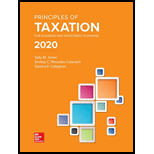
a.
Determine if the given situation amounts to tax avoidance or tax evasion.
a.
Explanation of Solution
Tax Avoidance Vs Tax Evasion: Tax avoidance refers to legalized means of reducing the tax liabilities by the taxpayers through tax planning, on the other hand, illegal means to avoid tax is known as tax evasion which is considered as offence and punishable under law.
In this case, since Mr. L is engaged in concealing his real income and understating it deliberately to avoid tax liability, this would be considered as tax evasion.
b.
Determine if the given situation amounts to tax avoidance or tax evasion.
b.
Explanation of Solution
In this case, since Mr. P did not conceal any of his income rather encourages his son who is with lesser marginal tax rate than him, to invest $50,000, Mr. P is said to be engaged in tax avoidance.
c.
Determine if the given situation amounts to tax avoidance or tax evasion.
c.
Explanation of Solution
In this case, since Mr. Q did not reveal truth in reporting his current years’ profit in the previous year just to gain by the lower marginal tax, he is deliberately trying to cheat the authorities by wrong reporting of income and thus, would be considered as tax evasion.
Want to see more full solutions like this?
Chapter 4 Solutions
Principles Of Taxation For Business And Investment Planning 2020 Edition
- Hi expert please given correct answer with accountingarrow_forwardPlz correct answer .arrow_forwarddont give unhelpful you are posting i am also . you are answering my question also Please listen if you will give unhelpful i will also give unhelpful . see you also answered my questions . I am giving warning am not giving unhelpful to your answer but you deslike my answer anymore i will deslike alsoarrow_forward
- Please listen if you will give unhelpful in my answer i will also give unhelpfulin your ans . see you also answered my questions . I am giving warning am not giving unhelpful to your answer but you deslike my answer anymore i will deslike alsoarrow_forwardPlato Ventures reports sales revenue of $285,000 and the cost of goods sold is $163,000. What is the gross profit for the period? A) $112,000 B) $98,000 C) $122,000 D) $148,000arrow_forwardPlease correct solution.arrow_forward
 Individual Income TaxesAccountingISBN:9780357109731Author:HoffmanPublisher:CENGAGE LEARNING - CONSIGNMENT
Individual Income TaxesAccountingISBN:9780357109731Author:HoffmanPublisher:CENGAGE LEARNING - CONSIGNMENT





